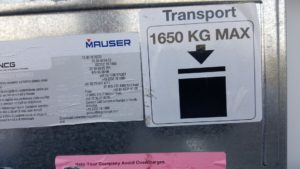A question back on April o2, 2018:
I know ibc totes can be stacked but not recommend when full ( flammable), so can they be double stack when empty and still be labeled ( flammable)? I’ve read that totes have to be cleaned and labels removed can you please clarify, my safety director says that they can even when labeled empty w/flammable labels still on them. Thanks Your feedback will be appreciated.
My reply:
That’s a tough question to answer because it combines the regulations of the USDOT/PHMSA (with which I am familiar) with those of OSHA (with which I am not familiar). Please see below.
- Per USDOT/PHMSA Hazardous Materials Regulations at 49 CFR 173.703(a)(1)(vii) each IBC must be marked with its stacking test load in kilograms. If an IBC is not designed for stacking, the figure of zero “0” must be displayed.
- Also, per 49 CFR 178.703(b)(7), an IBC manufactured, repaired, or remanufactured after January 01, 2011 must display a symbol indicating if it is designed for stacking or not designed for stacking.
- The USDOT regulates an “empty” IBC the same as if it was full unless it is cleaned of all vapors or filled with non-hazmat so no hazard remains. Read: USDOT Requirements for the Shipment of Empty HazMat Packagings
- Unless the IBC has been cleaned of all hazards and had all labels and marks removed it must be managed “empty” the same as when it was full so the stacking load limits would still apply.
- The above regulations only apply to the IBCs when they are in transportation, being prepared for transportation, or being loaded or unloaded. There may be regulations of OSHA that limit their stacking aside from the regulations of the USDOT.
I hope this helps. Please contact me with any other questions.
|
Contact me with any questions you may have about the transportation of hazardous materials by air, highway, vessel, or rail International and Domestic Daniels Training Services, Inc. 815.821.1550 |
That seemed to do it!:
Thanks for the information very helpful.
Conclusion:
This Q&A displays a common occurrence in HazMat transportation: people assume they know the regulations or rely on the assumptions of others instead of using the HMR themselves as the determination of compliance. Make certain that your compliance is based on the Hazardous Materials Regulations of USDOT/PHMSA and not what you’ve “heard” or what others have told you. Just one of the requirements of the HMR is that you provide initial and triennial HazMat Employee training.
